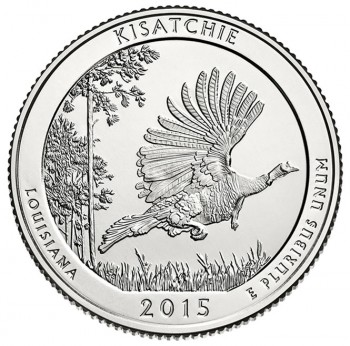Kisatchie National Forest of Louisiana is the second national site honored in 2015 from the United State Mint’s program of America the Beautiful Quarters. The 2015 Kisatchie National Forest Quarter marks the 27th release overall in the series, which is scheduled to run from 2010 to 2021.
Several key dates for the quarter include its release into general circulation on April 13; the release of U.S. Mint Kisatchie quarter rolls and bags on April 20 at www.usmint.gov; and the quarter’s official launch ceremony at Alexandria Riverfront Center in downtown Alexandria on April 22.
Its reverse or tails side has a design emblematic of the Kisatchie National Forest, which Louisiana’s only forest. Designed by Susan Gamble and sculpted by Joseph Menna, it depicts a wild turkey in flight over blue stem grass. There is also a long leaf pine in the background.
Inscribed around the image are KISATCHIE, LOUISIANA, 2015, and E PLURIBUS UNUM. This design was chosen by the Secretary of the Treasury from among eight design proposals. This same design appears on a series of five ounce silver coins also issued by the U.S. Mint.
Before the Kisatchie National Forest Quarter, there was 2015 Homestead National Monument of America Quarter (NE). Later released 2015 quarters include those honoring the Blue Ridge Parkway (NC), Bombay Hook National Wildlife Refuge (DE) and Saratoga National Historical Park (NY).
Kisatchie National Forest information
Kisatchie National Forest is located in Louisiana and consists of over 604,000 acres of forested area. This national forest contains bayous, bald cypress groves, and other growths, all located in seven different parishes in the state.
Tourists can participate in a number of activities such as boating, fishing, horseback riding, and camping. There are also a number of recreational sites with over 100 miles of trails for visitors.
Kisatchie National Forest was designated in 1930, in an effort to protect the natural resources in the area.

